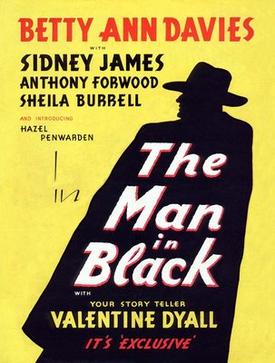Top Qs
Timeline
Chat
Perspective
The Man in Black (film)
1950 British film From Wikipedia, the free encyclopedia
Remove ads
The Man in Black is a 1950 British second feature ('B')[2] thriller film produced by Hammer Films, directed by Francis Searle and starring Betty Ann Davies, Sheila Burrell, Valentine Dyall and Sid James.[3][4] It was written by John Gilling from a story by Searle, which in turn was based on the popular British radio series Appointment with Fear by John Dickson Carr which featured Valentine Dyall as "The Man in Black".[5] Dyall provides the on-screen introduction to the film.[6] Jimmy Sangster was the assistant director. This was the first film Hammer ever produced at Oakley Court. Production began on 8 Aug. 1949, and the film was released in January 1950 (in UK only). As this film was in production, James Carreras traveled to the United States to sign a distribution deal with Robert L. Lippert which resulted in Hammer's films being better distributed in the US in the early 1950s.[7]
Remove ads
Remove ads
Plot
After the death of her millionaire father Henry Clavering during a freak "yoga accident" brought about by his second wife, Joan Clavering returns home to her widowed stepmother Bertha. Henry has left a large sum of money to Bertha, but has left the vast bulk of his fortune to Joan, unless she is mentally incapacitated in some way. Bertha conspires with her daughter Janice (from an earlier marriage) and Janice's fiancé Victor to drive Joan insane and thus deprive her of her rightful inheritance. When Hodson the butler tries to expose their scheme, he is murdered and his body is hidden in an underground vault. Joan tells Bertha and Janice that she is psychic and has received some messages from Hodson from beyond the grave, and she sets up a séance to prove it. During the séance, Joan's father Henry appears, and not as a ghost. He used his yogic abilities to simulate his death, in order to expose Bertha's nefarious scheme to the police.
Remove ads
Cast
- Betty Ann Davies as Bertha Clavering
- Sheila Burrell as Janice
- Sidney James as Henry Clavering / Hodson
- Anthony Forwood as Victor Harrington
- Valentine Dyall as Your Storyteller, the Man in Black
- Gerald Case as doctor
- Hazel Penwarden as Joan Clavering
- Laurence Baskcomb as Sandford
- Courtney Hope as Carter
- Mollie Palmer as Elsie
Critical reception
The Monthly Film Bulletin wrote: "Preposterous melodrama from the radio series. Betty Ann Davies and Sheila Burrell, as the most transparent villainesses since Lady Audley, are good for a number of laughs, but this was not, presumably, the intention."[8]
TV Guide wrote, "The story is drivel, with some unintentionally campy plot developments. It was adapted from a British radio series, perhaps proving that some dramas are better heard than seen."[9]
Fantastic Movie Musings and Ramblings wrote, "One of Hammer's earlier forays into horror. This one is highly recommended."[10]
Leonard Maltin called it a "clever little thriller with some surprises and a rare noncomic role for James."[5]
In British Sound Films: The Studio Years 1928–1959 David Quinlan rated the film as "mediocre", writing: "Ridiculous chiller at least moves along a fair rate."[11]
References
External links
Wikiwand - on
Seamless Wikipedia browsing. On steroids.
Remove ads

